Claude Code vs Codex: Why I Use Both (And You Should Too)
Everyone’s asking “Claude Code vs Codex – which one should I use?”
You’re asking the wrong question.
After tons of testing Claude Code vs Codex head-to-head, I discovered something game-changing: they’re not competitors, they’re the perfect team.
- Claude Code builds brilliantly,
- Codex reviews meticulously, and
- Together they create code that’s both powerful and bulletproof.
Let me show you exactly how this works with a real example from my WordPress theme.
.
.
.
Claude Code vs Codex: The Problem With Choosing Just One
Codex (GPT-5 High) Alone: Minimal to a Fault
Ask Codex to build something from scratch, and you’ll get code that works… technically.
But it’s like asking for a house and getting a tent.
Sure, it provides shelter, but is that really what you wanted?
In the Claude Code vs Codex comparison, Codex’s minimalism means:
- Basic functionality only
- No edge case handling
- Missing quality-of-life features
- Requires significant enhancement
Claude Code Alone: The Over-Engineering Trap
Claude Code (especially Opus 4.1) goes the opposite direction.
Ask for a simple feature, and it builds you a spacecraft.
The code becomes so complex that even Claude loses track of what it created.
The over-engineering pattern:
- Abstract factories for simple functions
- Unnecessary design patterns
- 20 files when 3 would suffice
- Complexity that breeds bugs
.
.
.
Claude Code vs Codex: The Solution is Both
After extensive testing of Claude Code vs Codex in production environments, here’s the breakthrough: Use Claude Code to build, then Codex to review.
When comparing Claude Code vs Codex strengths:
Claude Code excels at:
- Understanding requirements
- Creating comprehensive implementations
- Handling complex integrations
- Building from scratch
GPT-5 (Codex) excels at:
- Finding security vulnerabilities
- Catching inconsistencies
- Identifying missing edge cases
- Suggesting surgical improvements
Together, they’re unstoppable.
.
.
.
Real-World Example: Claude Code + Codex in Action
Let me walk you through exactly how Claude Code + Codex work together on a real feature – adding a newsletter subscription shortcode to my WordPress theme.
Phase 1: Claude Code Implementation
I asked Claude Code to do two things:
- Create a newsletter subscribe form shortcode
- Add a guide tab in the theme options to show users how to use this shortcode
Here’s my original prompt:
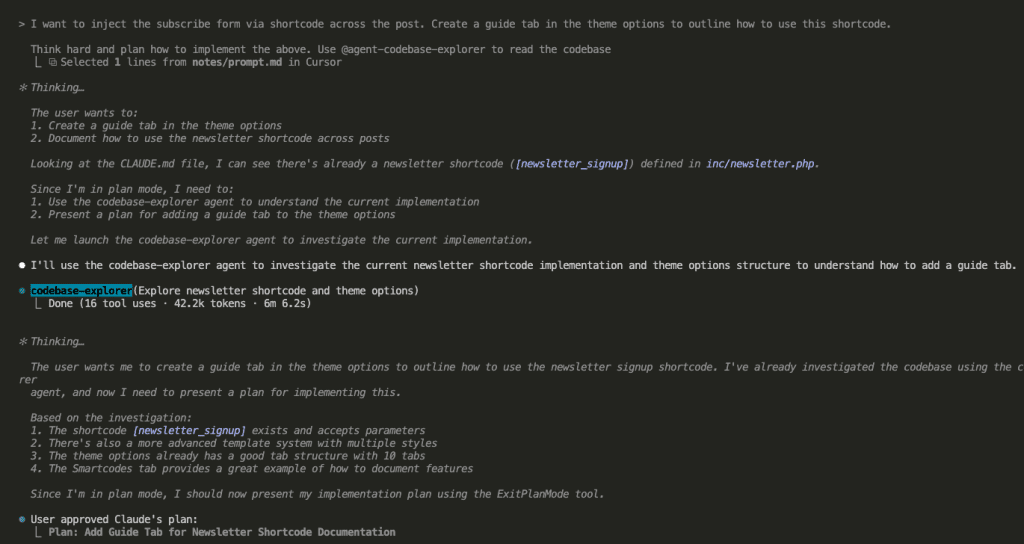
Claude Code immediately understood the context and used a sub-agent to explore the codebase:

After investigation, Claude successfully implemented both the shortcode and the guide tab:

The initial implementation included:
- ✅ Newsletter subscribe form shortcode
- ✅ Guide tab added to Theme Options
- ✅ Advanced template system with 6 visual styles
- ✅ Comprehensive documentation for users
- ✅ Integration features with FluentCRM
- ✅ Best practices and placement recommendations

Phase 2: Codex Review
This is where the magic happens.
I took Claude Code’s implementation and gave it to Codex for review:
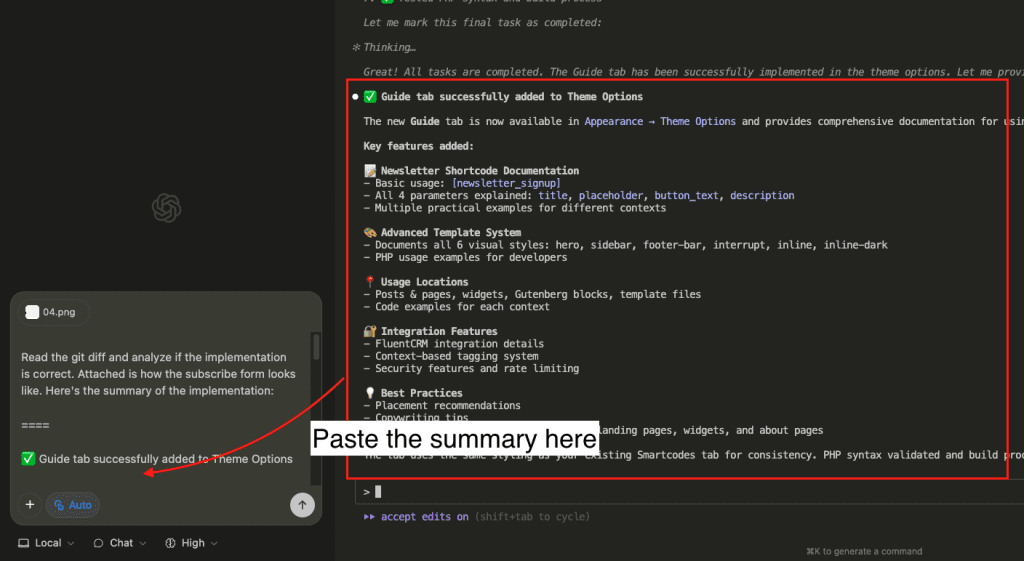
My exact prompt to Codex was simple: “Read the git diff and analyze if the implementation is correct. Attached is how the subscribe form looks like.”
Codex immediately went into detective mode:

Codex immediately went into detective mode, analyzing every aspect:
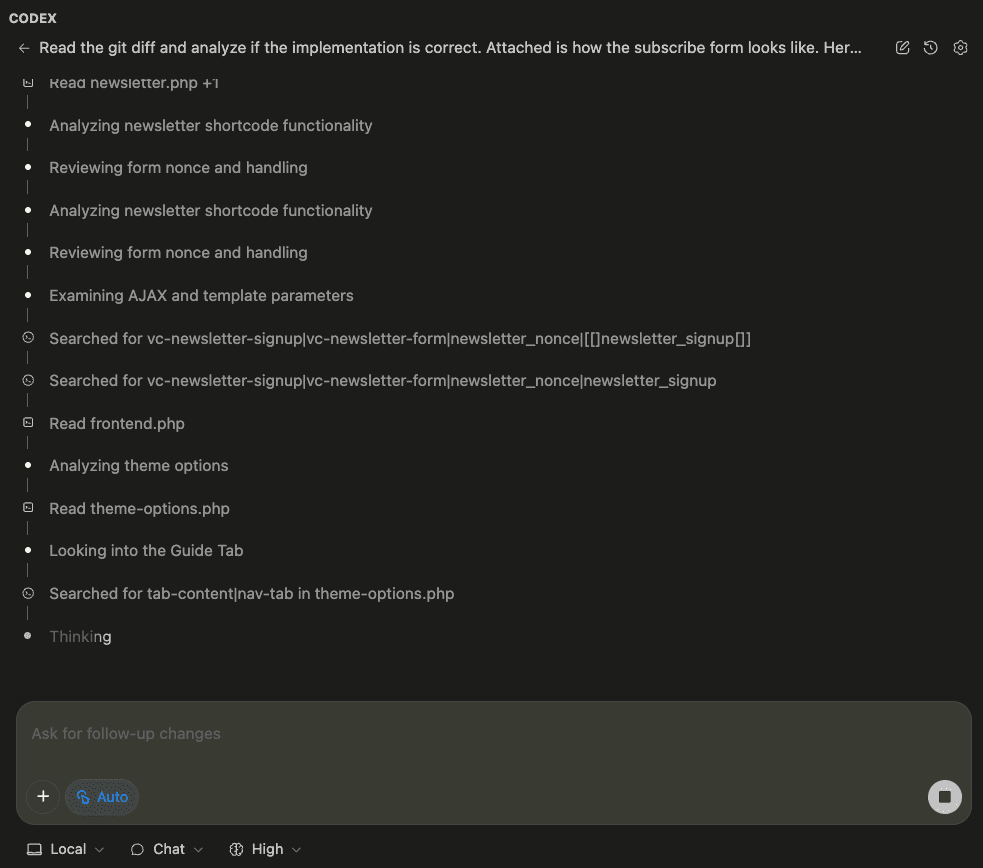
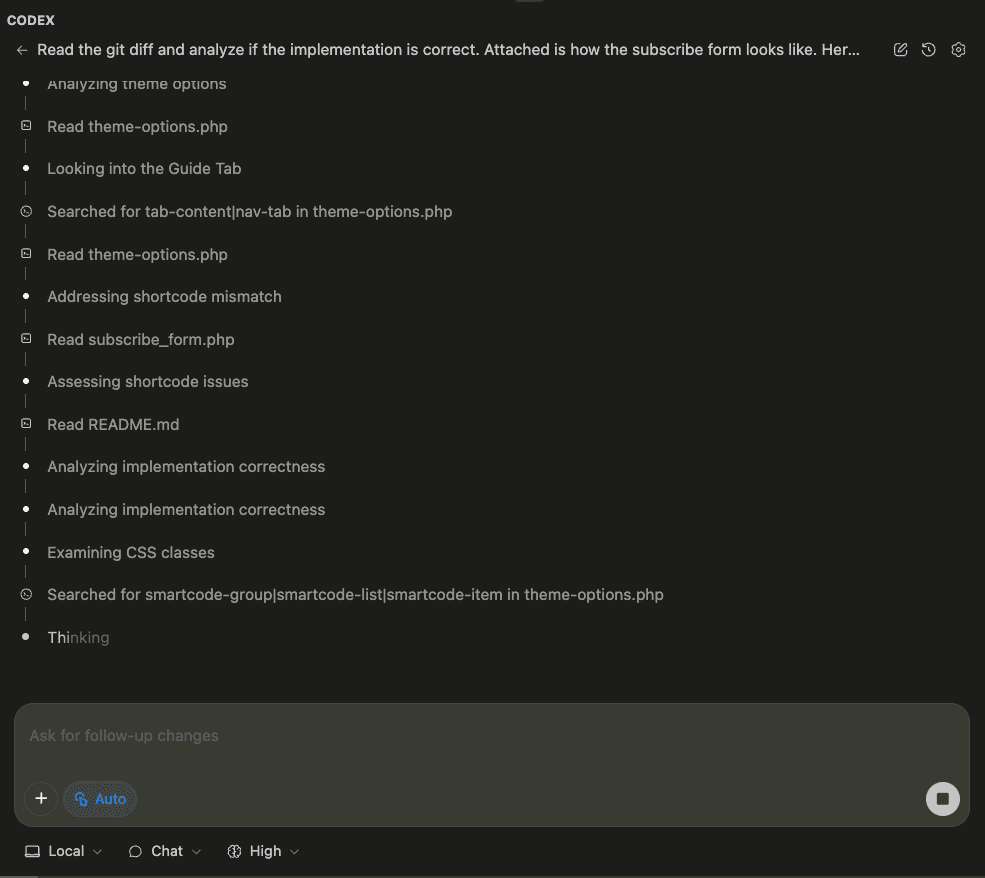
The Meticulous Review Results
After thorough analysis, Codex identified several critical issues that Claude Code missed:
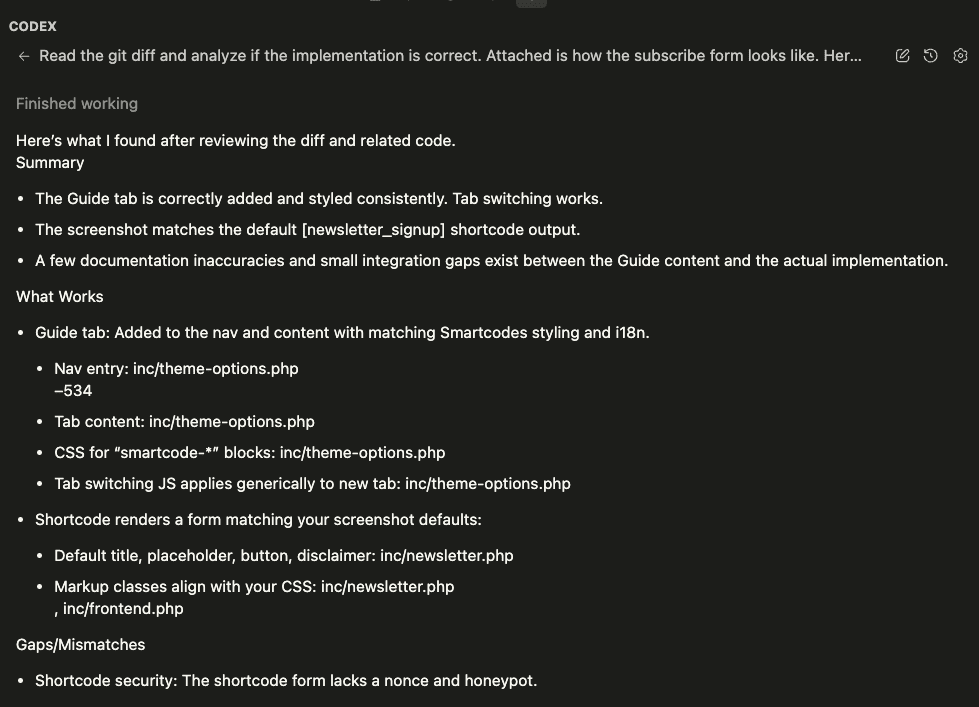
What Codex Found:
- Security Gap: The shortcode form lacked nonce and honeypot protection
- No
wp_nonce_fieldin the shortcode form - Template had security features, but shortcode didn’t use them
- No
- Integration Issues:
- Shortcode posted to wrong endpoint
- AJAX handler expected different parameters
- JS selector wouldn’t catch all form variants
- Documentation Mismatches:
- PHP usage example was incorrect
- Guide showed wrong template path syntax
- Style parameter documentation was misleading
- Small but Important Details:
- Footer template had a stray “◆” character instead of proper close icon
- Hidden context field missing for non-JS submissions
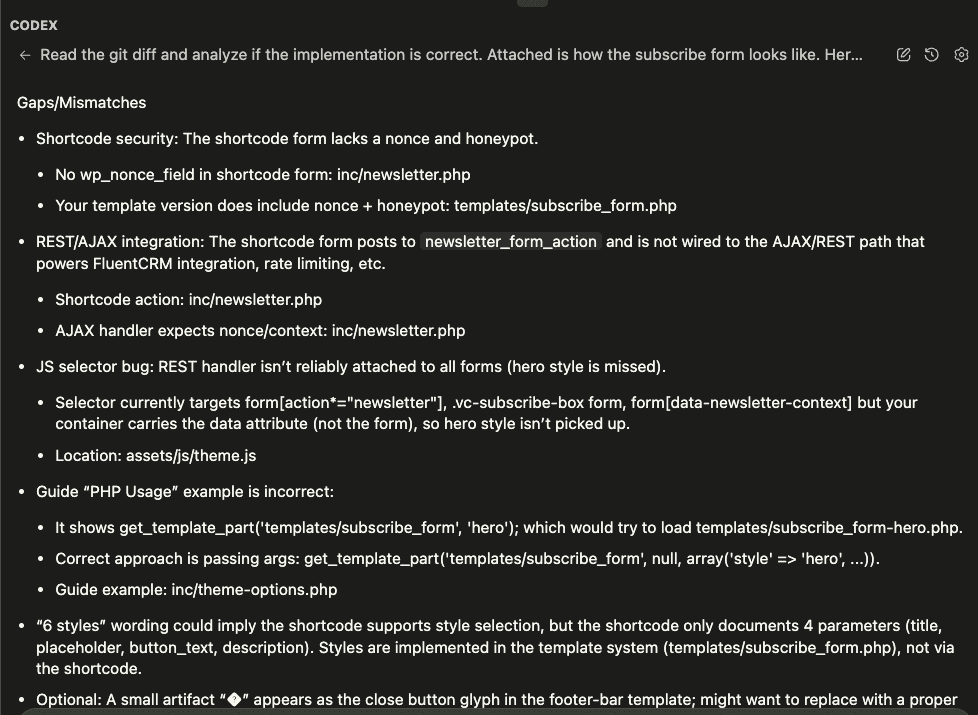
Join The Art of Vibe Coding—short, practical emails on shipping with AI (without the chaos).
No spam. Unsubscribe anytime. Seriously.
Want techniques like these weekly?
Phase 3: Applying the Fixes (With a Twist)
Here’s where I made an interesting choice.
Instead of taking Codex’s recommendations back to Claude Code, I asked Codex itself to apply the fixes:
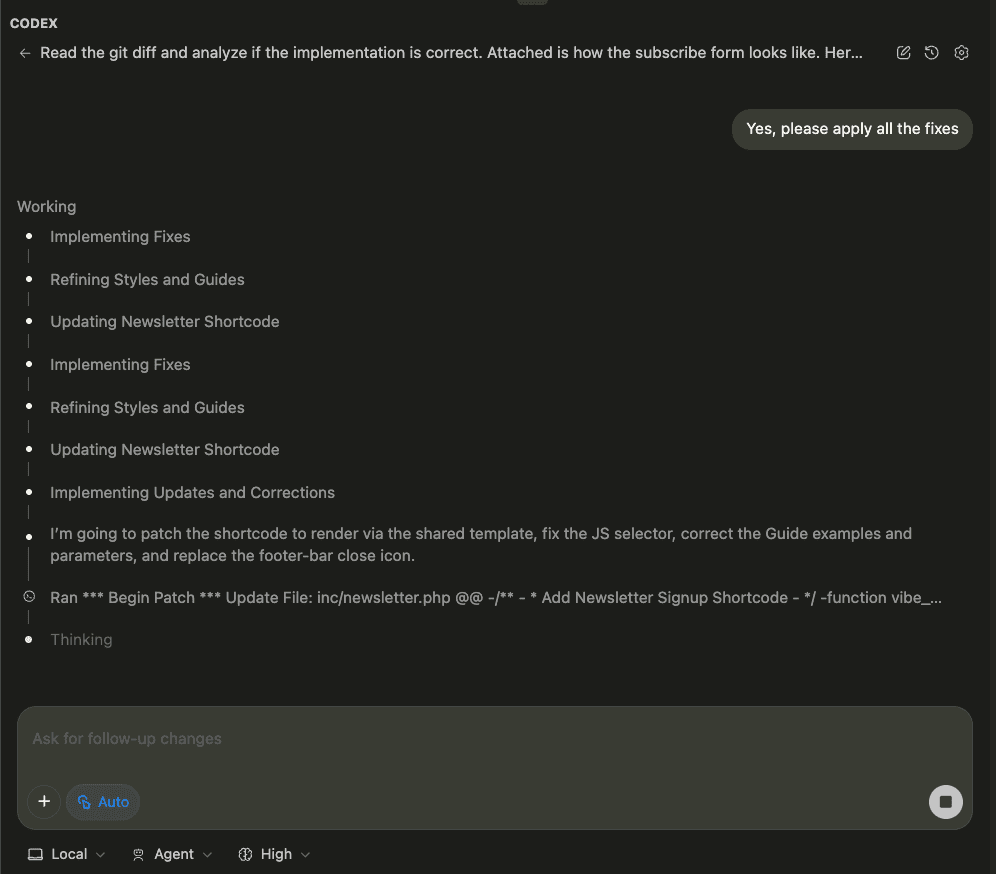
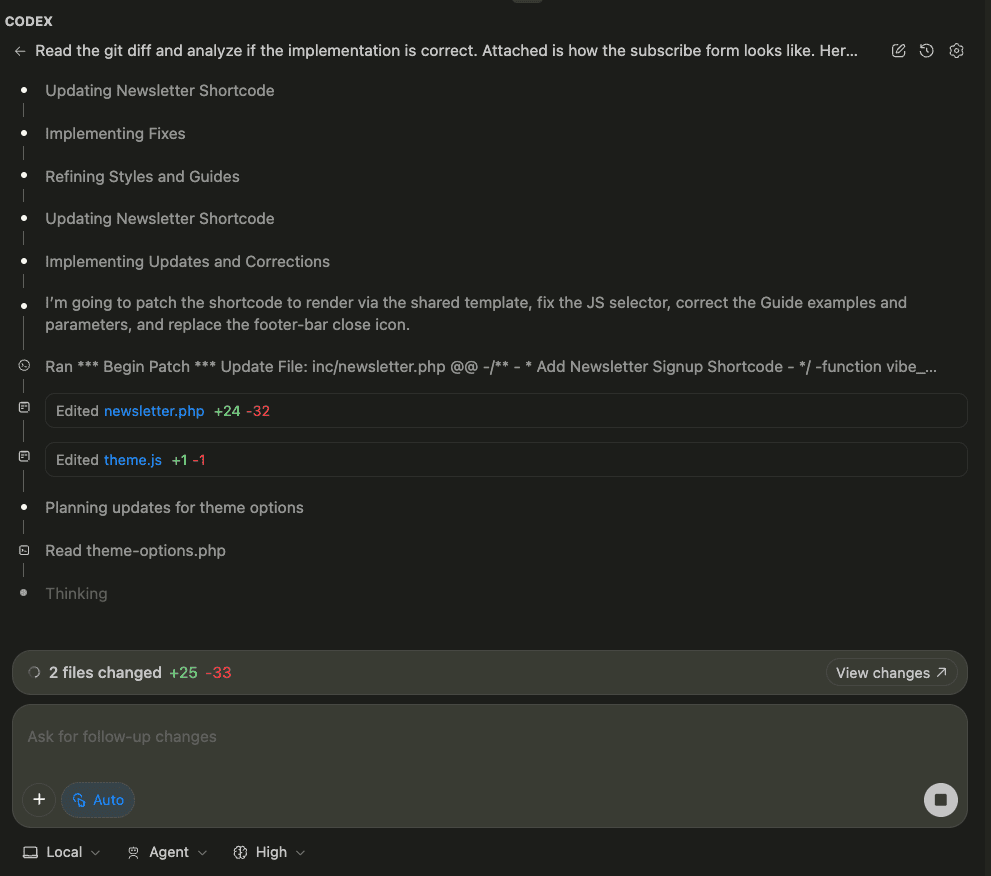
Why did I choose Codex over Claude Code for the fixes?
I wanted to test if Codex could handle implementation as well as review.
Spoiler: it absolutely can.
Codex methodically applied each improvement:



Note: You could absolutely ask Claude Code to apply these fixes instead. Both approaches work. The choice depends on your workflow preference and which tool already has the most context about your specific requirements.
The Final Result
The difference was night and day:
Before Codex Review:

After Codex Review:

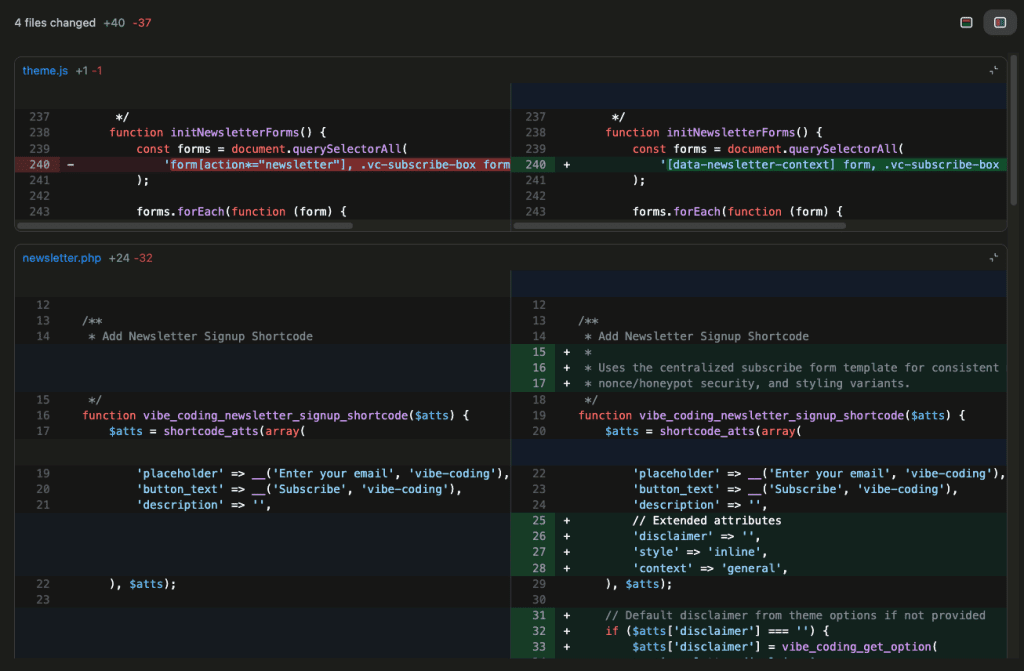

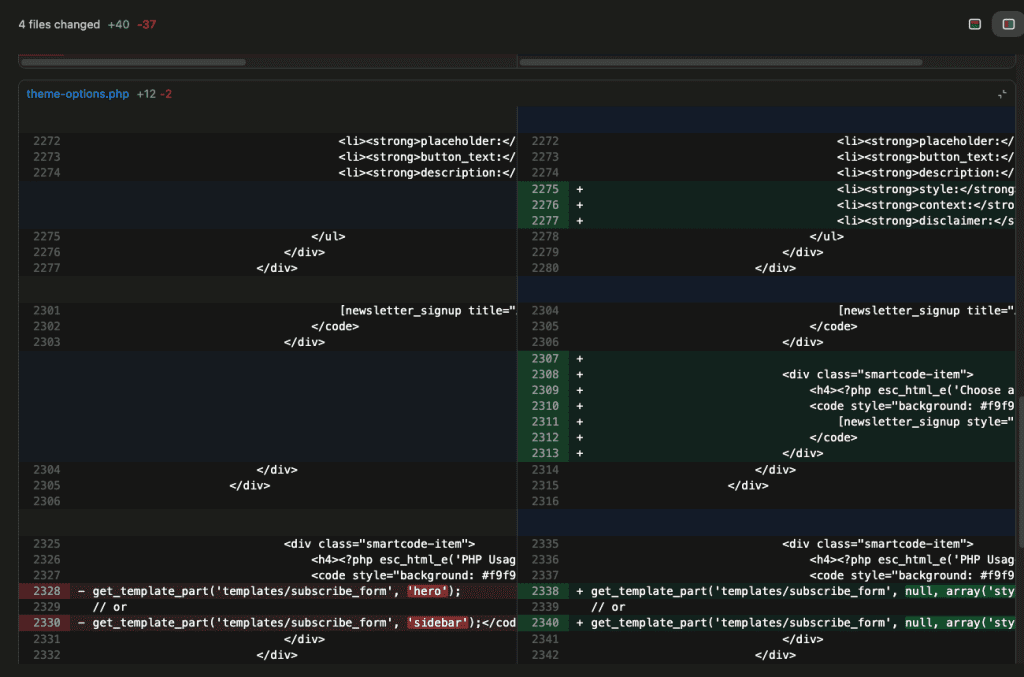
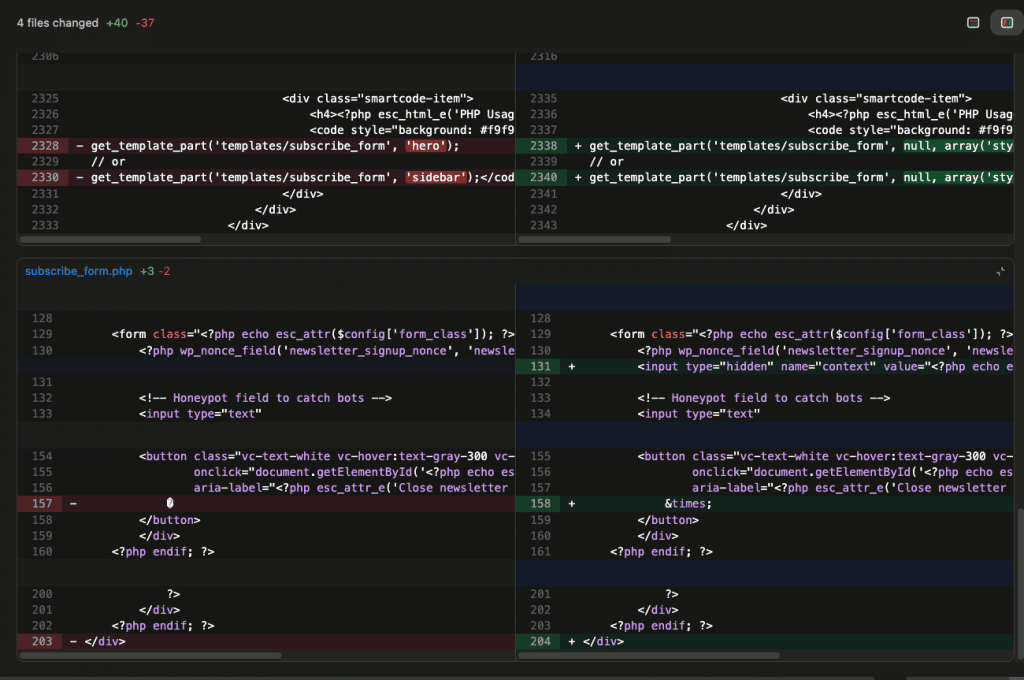
The final implementation now included:
- ✅ Full security with nonce + honeypot
- ✅ Proper AJAX/REST integration
- ✅ Consistent styling across all contexts
- ✅ Accurate documentation
- ✅ Clean UI with proper icons
- ✅ Hidden context field for fallback
.
.
.
The Workflow That Changes Everything
Here’s my exact process:
Step 1: Initial Implementation with Claude Code
"Build [feature] following our project rules"
Let Claude Code do what it does best – create comprehensive implementations.
Step 2: Export for Review
Generate a git diff or summary of changes. Include:
- The implementation code
- Any UI screenshots
- The intended functionality
Step 3: Codex Review
"Review this implementation for security, consistency, and correctness. Attached is [git diff/code/screenshots]"
Watch as Codex finds issues you never would have caught.
Step 4: Apply Improvements (Two Options)
Option A: Ask Claude Code to apply the fixes
"Apply these recommended fixes: [Codex's feedback]"
Claude Code implements the improvements with full context of the original implementation.
Option B: Ask Codex to apply the fixes directly
"Yes, please apply all the fixes"
Codex can handle both review AND implementation – as I demonstrated in this example.
Both approaches work.
Choose based on:
- Which tool has more context about your requirements
- Your comfort level with each tool
- The complexity of the fixes needed
.
.
.
Why Claude Code & Codex Together Works So Well
Complementary Strengths
The Claude Code vs Codex combination leverages what each does best:
Claude Code brings:
- Creative problem-solving
- Comprehensive implementations
- Deep context understanding
- Rapid development
Codex brings:
- Meticulous attention to detail
- Security vulnerability detection
- Consistency checking
- Edge case identification
.
.
.
Pro Tips for Maximum Effectiveness
1. Let Claude Code Explorer First
Always use Claude Code’s codebase-explorer agent for initial investigation.
It understands context better than starting fresh.
2. Be Specific with Codex
Don’t just say “review this.” Say:
- “Check for security vulnerabilities”
- “Verify integration points”
- “Validate documentation accuracy”
3. Screenshot Everything
Visual proof helps both AIs understand what you’re building.
4. Don’t Skip the Review
Even if Claude Code’s implementation seems perfect, run it through Codex.
Those “small” issues compound into big problems.
5. Keep the Feedback Loop Tight
Apply fixes immediately while context is fresh.
Don’t let reviews pile up.
.
.
.
The Bottom Line: Claude Code vs Codex is the Wrong Question
Stop treating Claude Code vs Codex as an either/or decision.
Start using them as collaborators.
The Claude Code vs Codex debate misses the point entirely.
They’re not competitors fighting for your attention – they’re complementary tools that achieve greatness together.
Claude Code is your brilliant architect who designs and builds. Codex is your meticulous inspector who ensures everything is perfect.
Together, they don’t just write code – they craft production-ready solutions that are secure, consistent, and maintainable.
My newsletter shortcode went from “it works” to “it’s bulletproof” in one review cycle.
That’s the power of using the right tool for the right job.
Your next feature deserves both the creativity of Claude Code and the precision of Codex. Why settle for less?
P.S. – This workflow has become so essential that I now budget time for both implementation and review in every feature. The 30 minutes spent on review saves hours of debugging later. Try it on your next feature and see the difference.
Leave a Comment